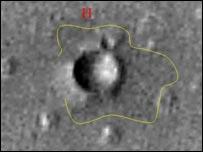A crater with a diameter of a kilometer and a depth of 700 meters was discovered in the center of the Beagle 2 landing site. If she fell into it, she could have encountered many dangers
30.12.2003
Did Beagle 2 fall into this crater?

Beagle 2 may have fallen into a recently discovered crater on Mars near the lander's planned landing area. This is what scientists in the project now claim. The crater was discovered in the Isidis plain, a flat basin on Mars where Beagle was supposed to land and apparently it was supposed to be a safe surface for her.
The scientists said that there is a possibility, although not high, that Beagle found herself in a crater that is about a kilometer wide. If she is there, there is no way she can contact Earth.
The spacecraft's creator, Prof. Colin Pillinger, said that this is the "worst case scenario", but he added. “We should be extremely unlucky if she went straight down into the crater. The crater itself, which does not yet have a name, is roughly in the middle of the landing ellipse designated for the Beagle.
The crater was discovered by the Mars Global Surveyor spacecraft orbiting Mars. The Malin Space Science Systems Center, which operates the camera on board the Mars Global Surveyor, identified it and sent the images to the Beagle team on Sunday (28/12/03) night. If the Beagle did disappear into the crater it could be devastating for the mission. Landing too hard on the sides of the crater, which may have a depth of 700 meters, can damage the lander. A crater can also create a shadow that will make it impossible to charge the spacecraft's batteries using the solar panels.
If the crater is also surrounded by rocky remains, this could cause the airbags to collide or prevent the spacecraft from properly opening the solar collectors. However, the Beagle team says that this is only one of the scenarios being tested.
The scientists established a "tiger team" - which includes experts from various fields who will scan all the possible reasons for the silence. The group, operating out of Britain's National Space Center, were equipped with a life-size engineering model of the spacecraft with all its systems and all the engineering documents and drawings. The team developed a series of blind commands that must be sent to the spacecraft to make it respond. These commands are blind in the sense that we have no idea if they reach their destination, but we are going to try," said Prof. Alan Wells, senior scientist on the Beagle team.
